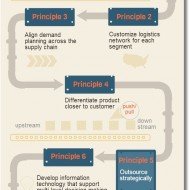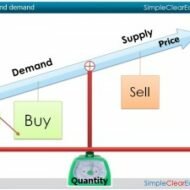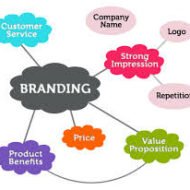Posted by Managementguru in Business Management, Marketing, Operations Management, Project Management, Sales
on Feb 3rd, 2015 | 0 comments

What is Supply Chain Management? Investopedia: Supply chain management (SCM) is the streamlining of a business’ supply-side activities to maximize customer value and to gain a competitive advantage in the marketplace. SCM represents an effort by suppliers to develop and implement supply chains that are as efficient and economical as possible. Wikipedia: Supply chain management (SCM) is “the systemic, strategic coordination of the traditional business functions and the tactics across these business functions within a particular company and across businesses within the supply chain, for the purposes of improving the long-term performance of the individual companies and the supply chain as a whole.” Business Dictionary: Management of material and information flow in a supply chain to provide the highest degree of customer satisfaction at the lowest possible cost. SCM requires the commitment of supply chain partners to work closely to coordinate order generation, order taking, and order fulfillment. They thereby create an extended enterprise spreading far beyond the producer’s location. 7 Principles of SCM Supply Chain Management in Simpler Terms: The EFFECTIVE movement and management of materials and information as they flow from their source to the end customer. Supply Chain encompasses purchasing, manufacturing, warehousing, transportation, customer service, demand planning and supply planning. SCM is a daunting task and calls for proper planning and execution. OBJECTIVES OF FORECASTING SCM is the control of the supply chain as a process from supplier to manufacturer to wholesaler to retailer to consumer. SCM does not only comprise the passage of a physical product through the chain but also any data that goes along with the product (such as order status information, payment schedules, and ownership titles) and the actual entities that handle the product from stage to stage of the supply chain. There are essentially three goals of SCM: To reduce inventoryTo increase the speed of transactions with real-time data exchange andTo increase revenue by satisfying customer demands more efficiently. When you think of the world’s most efficient and successful performance and supply chains, what comes to mind? For me it is not Wal-mart or Pepsi but Mumbai Dabbawalas – Watch this Video. The Success of Supply Chain of Dabbawalas in Mumbai –Said to be Six Sigma Compliant No over-reliance on technology, all manual operationsCreate an integrated performance chain, the chief, team leaders and delivery men.Acute visibilityKeep it simple. Real simple with a color coding to identify where the food has to be delivered and to whom.Timely Delivery as the shelf life of food is 4-5 hours. Why is it so important for companies to get products to their customers quickly? Faster product availability is significant to increasing sales and there’s a sizeable profit advantage for the extra time that you are in the market and your competitor is not. The earlier and faster you are in the market, the more orders and market share you enjoy. The ability to deliver a product faster also can make or break a sale. If two competitive products appear to be equal and one is immediately available and the other will be available in a week, which would you choose? Supply Chain Management is all about moving goods more quickly to their destination in a strategic and tactical manner. Supply Chain Management Tomorrow: The future for Supply Chain Management looks very bright. Two major trends are benefiting Supply Chain Management operations- Customer service focus and Information technology. Successful organisations must excel in both of these areas, the fundamental objective being to “ADD...

Posted by Managementguru in Economics, Financial Management, Principles of Management
on Mar 15th, 2014 | 0 comments

Demand vs. Supply- Parameter deciding market equilibrium The success of economic freedom of a country is naturally reflected in the form of human prosperity. Countries like India are evidencing a consistent increase in their annual GDP rates which obviously must have reduced the population percentage living below poverty line; yet this has not been accomplished and the question is, is it really something to do with the economic model or is it the bureaucracy and inefficiency the root cause for the strain in the economy? Flow of Economic Activity: This discussion aims at shedding some light on the flow of economic activity in a free market economy. The elemental players or contributors in a free enterprise market economy are individuals and firms. Individuals who own or control resources (in the form of labor, capital or natural resources), sell these resources to firms and obtain money. These resources which serve as necessary inputs in the production process add value to firms. The money received by individuals is called factor payment which is utilized to fulfill their consumption demands of goods and services. Two distinct areas of interaction exist between the individuals and firms. One is the product market where the products are bought and sold and the other being a market for production factors, where the inputs such as labor, capital and natural resources are traded. What is the activity in a product market? Fundamentally business is all about demand vs. supply. The consumers’ demand has to be met with by the manufacturers. Profit is the primary motive of any firm and the priority of a firm lies in responding to the demands of the consumer market by supplying goods and services to the potential and prospective buyers. Input costs and production technology are the determinants of supply conditions. People’s preferences and earnings decide the elasticity of market demand. The price of the product and quantity sold is a result of the interaction between demand and supply. In a product market money flows from consumers to firms and goods and services flow from firms to consumers. What happens in a factor market? The reverse of those conditions in the product market are seen in a factor market. Here the individual becomes the supplier of production factors and hence the money flows from firms to individuals and factors of production from individuals to firms. Prices and profits control the flow of money and resources through the factor market and flow of money and goods through the product market. What is a Free Market Enterprise? Added advantage of a free market enterprise is that, the effortlessness with which one can enter and exit the market. The activity flow proves advantageous to each person involved .Firms make profits, individuals are satisfied of their consumption demand for goods and services, resource owners are compensated for their services. If an individual is not able to benefit by trading in these markets, he or she is not required to do so or free to leave the market which ensures that nobody is made worse off by voluntary trade in these markets. Essentially countries have to go in for suitable economic restructuring that promotes equality and even distribution of wealth. Wall Street protest in US is a clear-cut indication of strained market economy which is a result of people’s fury against the prevailing economic...

Posted by Managementguru in Business Management, Marketing, Principles of Management
on Mar 4th, 2014 | 0 comments

Trends in Consumer Marketing FMCG’s: Consumer marketing is defined as creating and selling products, goods and services to individual buyers, as opposed to trying to appeal to businesses. You would have often heard about this – Fast moving consumer goods. These are nothing but products that are destined for use by ultimate customers or households that cannot be done with, as their usage is on a day to day basis. It might make some sense if I cite some examples – toothpaste, soaps, shaving creams, talcs, body lotions; these are meant for personal consumption and the demand for such products is direct and needs less of relationship marketing. Brand Focus: The number of customers in the consumer market is relatively large and the product purchase is influenced by even emotional factors. The focus is on the brand name and some people ardently follow a particular brand for ages, and this might be attributed to the effect that has been created by mass media advertising, or it might be due to the fact that they might identify themselves in some or the other with the product. It becomes a personal companion over a period of time. Impulse Buying: The decision making process is informal and often simple. Sometimes, it is influenced by the budget equations and feasibility. Impulse buying is also common in consumer market. At times, the consumers go adventurous and like to try their hands on new products. Branding is an important feature that retains the customer base for business firms and that’s why market analysts are attaching so much of significance to advertisements and sales promotions, to make their product a household name. Distribution Network: The firms must have a pucca distribution network linking different parts of the territories, where they want to expand their market. Say, for instance, a soft drink can be made popular by branding, but if there is no sufficient supply in the market, how do you expect customers to support your product? Equally important is providing the customers with a product size that best suits their budget. Consumer Marketing Infographic: Researchomatic.com Market Segmentation: Market segmentation recognizes the existence of distinct market groups, each with a distinct set of needs. Through segmentation, the firm directs its product and promotional efforts towards those markets that will benefit most from or will get the greatest enjoyment from its merchandise. Over the years, segmentation has become a popular strategic technique as the market is ever flushed with competitors. Influence of Price: A number of sellers are seen in this kind of consumer market and it is only the market that decides the price and not the participants. The marketers have nothing to lose if they sell at the market price, but if they plan to sell at slightly higher price levels than that of the market, it will prove detrimental to their objective. https://www.businessmodelscholar.com/wp-content/uploads/2020/06/3.pdf They are only price takers and not price makers. But they have the leverage to freely enter and exit the market. If the consumers foresee a fall in the general price levels of a product, they wait for some more time to take full advantage of the situation and decide to postpone the purchase. If the market shows an increasing price trend, it is the other way round, either they buy in bulk or go for substitutes.Say, if the price levels of coffee is on the rise, people opt for tea. Demand for consumer goods is price elastic. Consumers don’t care for much technical specifications; they only care for the quality backed up by a strong brand name. Post by Free MBA...






